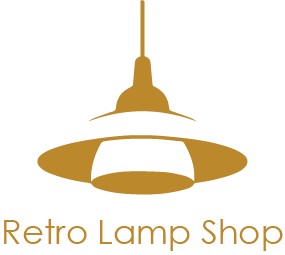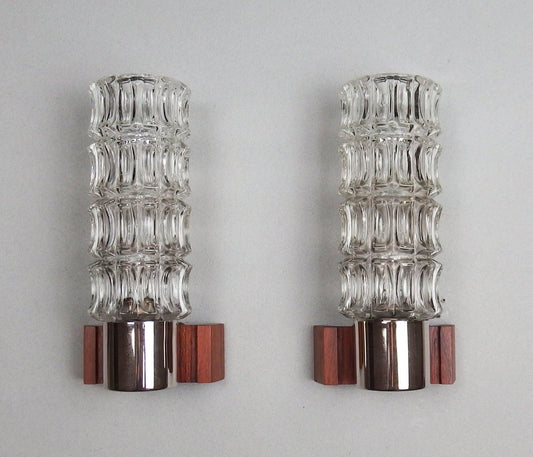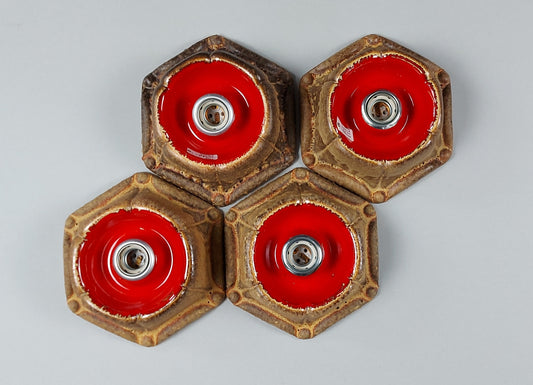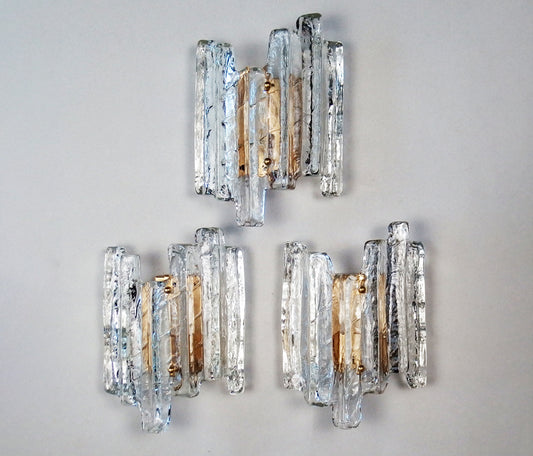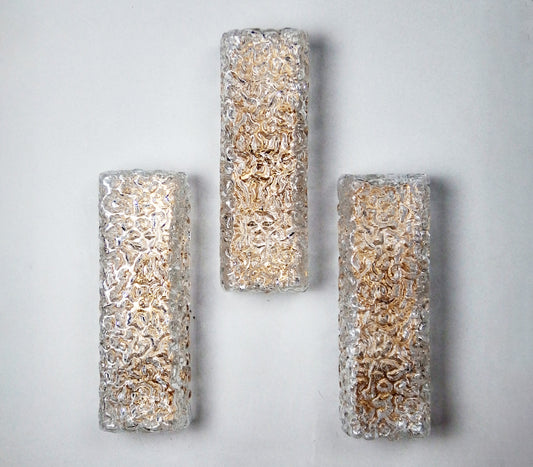Collection: Wall lights and sconces
This is a collection of authentic vintage sconces and light fixtures.
We have a very divers collection of wall lights . Brass or crome, handcrafted glass, ceramic or porcelain, each wall lights in this collection is a statement peace.
You will find here mainly european well known italian german fench danish and swedish and spanish brands: Mazzega, Mason Charles Jamsen. Lucien Gau paris, Axela, Temde, Doria, Kalmar, Fischer. Limburg, Sische, Ifo, Vitrika, Hillebrand, La Murina, Massive, Honsel, Hustadt, Staff, Palwa, kaiser, Pan Keramik, Sorensen, Peill & Puzler. Zimmer & Muller, Solken, Poliarte, Sciolari, Boulanger, Kinkeldey, Idearte, Metal arte, Faladesa, Fontana arte, WKR, TZ Scmitz, Baulmann, Brendel.
For a wider selection of 20th century lights, other than vintage sconces please explore our ceiling lightd collection and our table lights collection. Gain inspiration by visiting our Instagram page.
-
1 of 2 1960s pair of petite sconces with solid rosewood base and thick crystal glass shades
Regular price 1.402,00 lei RONRegular price -
1 of 2 pairs of 70's pop art, ceramic sconces with volcanic glaze from Honsel
Regular price 1.974,00 lei RONRegular price -
1 of 3 1970s Murano glass sconces from Fischer Leuchten
Regular price 1.730,00 lei RONRegular price -
1 of 3 70's bubble glass sconces with gold painted metal base from Limburg
Regular price 1.247,00 lei RONRegular price -
1 of 3 1970's Sciolari style 6 lights chrome sconces from Doria Leuchten
Regular price 1.506,00 lei RONRegular price -
1 of 3 stunning 1970's large Murano ice glass sconces with chrome base from Hillebrand
Regular price 2.077,00 lei RONRegular price -
Beautiful pair of 1970s chrome and clear glass sconces from Willa
Regular price 1.870,00 lei RONRegular price -

Beautiful pair of 1980's at deco inspired sconces with frosted glass shades and brass accessories
Regular price 1.662,00 lei RONRegular price -
Beautiful petit pair of 1960s Danish ceramic sconces with pineapple texturized glass from Lindner
Regular price 1.558,00 lei RONRegular price -
Elegant pair of 1950s opaline glass sconces with polished brass and off white painted base
Regular price 1.818,00 lei RONRegular price -
Elegant pair of 1960's brass sconces with striped opaline glass shades
Regular price 2.181,00 lei RONRegular price -

Elegant pair of 80's Swedish black painted metal and glass sconces with art deco influences
Regular price 1.195,00 lei RONRegular price -
One of 3 1970s sconces or ceiling lights with bubble glass shades and gold painted metal base from Limburg
Regular price 779,00 lei RONRegular price -
Pair Ifö Sweden wallmounted sconces | Porcelain | Model 6035 | Sigvard Bernadotte | vintage 60's
Regular price 1.558,00 lei RONRegular price -
Pair of 1950's double sconces with grooved opaline glass, brass and blue enamel accessories from Kaiser Leuchten
Regular price 2.337,00 lei RONRegular price -
Pair of 1970's fat lava red ceramic sconces from Hustadt
Regular price 2.389,00 lei RONRegular price
Designer Luminaires from the 1950s to the 1980s
The period from the 1950s to the 1980s marked a transformative era in design, particularly in the realm of lighting. As art, architecture, and interior design evolved, so too did the aesthetics and functionality of lighting. Designer luminaires, or designer light fixtures, became more than just functional objects. They morphed into artistic statements, reflecting the socio-cultural changes of their times. This period saw an explosion of creativity and innovation in lighting design, with key movements influencing the designs of the time, from mid-century modern to postmodernism.
1950s – Mid-Century Modern
The 1950s was a golden age for modernist design, and lighting was no exception. The era saw the rise of functional, minimalist designs that placed a premium on clean lines, organic forms, and an emphasis on simplicity. Mid-century modern designers such as George Nelson, Arne Jacobsen, and Isamu Noguchi revolutionized lighting with fixtures that embodied the period’s ethos of both style and practicality.
George Nelson’s Ball Clock and Bubble Lamps became icons of the era. These lighting fixtures were notable for their organic shapes, which were inspired by nature, yet executed with modern materials like plastic and metal. The Bubble Lamp, made of a translucent plastic material, was particularly influential. Its soft, diffused light contrasted with the stark, industrial lighting designs of the earlier decades, providing a more intimate and warm ambiance.
Arne Jacobsen, another luminary of the period, designed the AJ Lamp for the SAS Royal Hotel in Copenhagen in 1960. His geometric designs combined form and function, with the AJ Table Lamp and AJ Floor Lamp both offering directional lighting and a minimalist aesthetic that still felt luxurious.
Isamu Noguchi's Akari light sculptures, created in the late 1940s and into the 1950s, were influenced by traditional Japanese lanterns. Made of paper and bamboo, these pieces were delicate and ethereal, with a focus on form and texture. The Akari lights fused Japanese craftsmanship with modernist abstraction, making them one of the most important lighting designs of the 20th century.
1960s – The Space Age and Organic Design
The 1960s were heavily influenced by the Space Race, which reflected in the lighting designs of the time. Designers sought to create futuristic and experimental lighting that evoked a sense of innovation and exploration. The Space Age aesthetic introduced new materials like plastics and metals, as well as dramatic, sculptural forms.
Italian designer Gino Sarfatti, who had been creating innovative designs since the 1940s, became a significant figure in lighting design during the 1960s. His Model 2109 chandelier, made of a series of overlapping metal discs, exemplified the futuristic look of the time. Sarfatti's designs were not just functional but also artistic, combining modern materials and sculptural forms to create striking statement pieces.
Another influential designer from this period was Poul Henningsen, whose PH Artichoke lamp (1958) epitomized organic design. With its layered, overlapping leaves, the lamp provided a soft, diffuse light that was both striking and atmospheric. Its natural form was a departure from the more industrial designs of previous decades and captured the ethos of the Space Age and its fascination with fluid, organic shapes.
1970s – The Rise of Postmodernism
The 1970s was a decade of eclectic experimentation, with designers drawing on various influences from history, pop culture, and even the counterculture movements of the time. The result was an explosion of diverse styles, from disco-inspired glamour to organic, nature-infused shapes.
The 1970s also saw the rise of Italian lighting designers such as Mario Bellini and Ettore Sottsass, who were part of the postmodern movement. Bellini's Berenice lamp, designed in 1977, was a blend of functional lighting and bold geometric forms, reflecting the new artistic freedom of the postmodern era. The Berenice lamp's adjustable arm and minimalistic design became emblematic of the decade's desire to combine practicality with creativity.
Ettore Sottsass, a key figure in the Memphis Group, embraced bold colors, geometric patterns, and unconventional shapes in his lighting designs. His Tizio lamp (designed in 1972 by Richard Sapper) became an icon of the period. Featuring a balanced, articulated design with a distinctive black and chrome finish, it embodied the move toward more personal and unconventional lighting choices.
1980s – A Fusion of Minimalism and Excess
The 1980s was a time of fusion—where the stark minimalism of the previous decade met the more opulent, maximalist tastes of the emerging consumer culture. Designer lighting continued to evolve, and the decade saw a blend of futuristic, high-tech designs with a return to more lavish materials and decoration.
In the 1980s, the designer luminaire shifted towards more grandiose and statement-making pieces. Designers like Philippe Starck and Michael Graves embraced both minimalism and ornamentation. Starck’s Louis Ghost Chair and his lighting creations for companies like Flos offered sleek, transparent plastic fixtures with contemporary allure. Meanwhile, Graves’ designs for Alessi included the use of colorful plastics and playful forms that were symbolic of the era’s exuberance.
The 1980s also saw the growing influence of technology in lighting. The incorporation of halogen and fluorescent lighting, alongside innovations in materials, led to fixtures that could deliver more intense and energy-efficient light.
Conclusion
The period from the 1950s to the 1980s was pivotal in the history of designer luminaires. From the clean lines and organic forms of mid-century modernism to the bold and eclectic styles of the postmodern era, lighting design mirrored the cultural shifts and technological advancements of its time. Designer luminaires became more than just functional objects, evolving into expressions of art, innovation, and identity. Today, these iconic designs continue to influence modern lighting and remain a testament to the creativity and ingenuity of the mid-20th century.
